Fubotv earnings beat by $0.10, revenue topped estimates
Introduction & Market Context
Eve Holding Inc (NASDAQ:NYSE:EVEX) presented its Q2 2025 update on August 6, highlighting significant progress in its urban air mobility program. The company’s stock was down 2.24% in premarket trading to $6.55, following a 1.06% gain to $6.70 in the previous session. Despite continued investment in research and development contributing to ongoing losses, Eve has made substantial strides in both commercial agreements and technical development of its EVE-100 electric vertical takeoff and landing (eVTOL) aircraft.
The company’s presentation comes as the urban air mobility sector continues to mature, with Eve positioning itself as a comprehensive solution provider through its aircraft, services, and digital platforms. The company maintains its target for entry into service by 2027, with several key milestones expected in the coming months.
Strategic Initiatives
The most significant commercial development in Q2 was Eve’s announcement of its first binding eVTOL order. Revo, a urban air mobility subsidiary of OHI Group, committed to a $250 million purchase of 10 EVE-100 aircraft with options for 40 additional vehicles. The agreement includes TechCare service arrangements, with initial operations planned for São Paulo, Brazil, focusing on airport shuttle services before expanding worldwide.
As shown in the following slide detailing this landmark agreement:
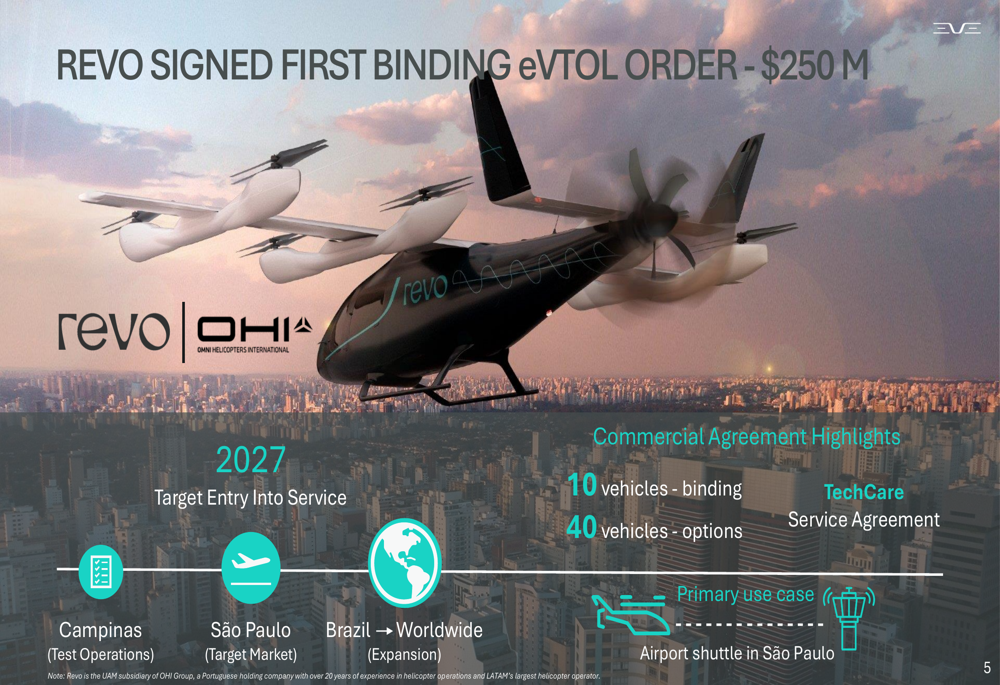
Beyond this binding order, Eve continues to expand its customer base with new Letters of Intent (LOIs). Future Flight Global signed an LOI for up to 54 eVTOLs serving Brazil and the United States, while Aerosolutions and Bluenest by Globalvia committed to up to 50 eVTOLs along with TechCare services.
Eve’s comprehensive approach to the market has resulted in an impressive customer portfolio across its three main business segments. The company now boasts 28 customers in 9 countries for its eVTOL aircraft, 14 customers and partners in 8 countries for its TechCare services, and 21 customers and partners in 10 countries for its Vector platform.
The following slide illustrates Eve’s expanding customer ecosystem and potential revenue streams:
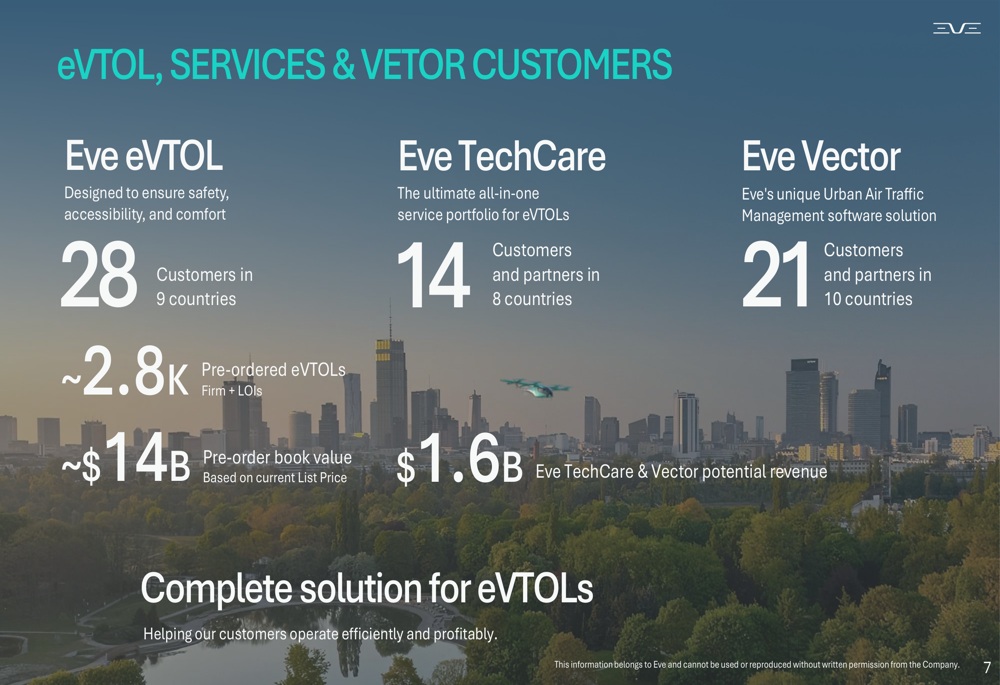
Quarterly Performance Highlights
While specific quarterly financial figures weren’t prominently featured in the presentation, Eve continues to invest heavily in research and development as it progresses toward certification and production. In the previous quarter (Q1 2025), the company reported a net loss of $49 million with $44 million allocated to R&D expenses.
The company maintains its 2025 cash consumption guidance of $200-250 million, noting that this projection is on track. Eve’s pre-order book now stands at approximately 2,800 aircraft with an estimated value of $14 billion based on current list prices. Additionally, the company projects $1.6 billion in potential revenue from its TechCare and Vector services.
Eve’s strong liquidity position, which stood at $411 million as of Q1 2025, provides runway for continued development activities. The company’s focus remains on efficient capital deployment as it progresses toward first flight and eventual certification.
Product Development Progress
Eve showcased significant design refinements to its EVE-100 aircraft during the quarter. The updated design features several key improvements including a wheeled taxing-gear option, redesigned and more aerodynamic wing, optimized cabin interior with lightweight seats, eight fixed-pitch lifters with a four-blade rotor design, and an intuitive cockpit with a four-axis sidestick paired with Embraer’s 5th-generation fly-by-wire technology.
The following slide details these design enhancements:

A full-scale prototype of the EVE-100 is now being prepared for its first flight, expected in late 2025 or early 2026. The company highlighted several technical achievements, including successful testing and installation of pusher motors, ongoing lifter testing, and a partnership with Beta Technologies as a new electric motor supplier.
The new rotor configuration features a 4-blade design with fixed pitch, which Eve claims will deliver reduced vibration, lower noise profile, and blades that fold to reduce drag during cruise flight. These developments were showcased in the following slide:
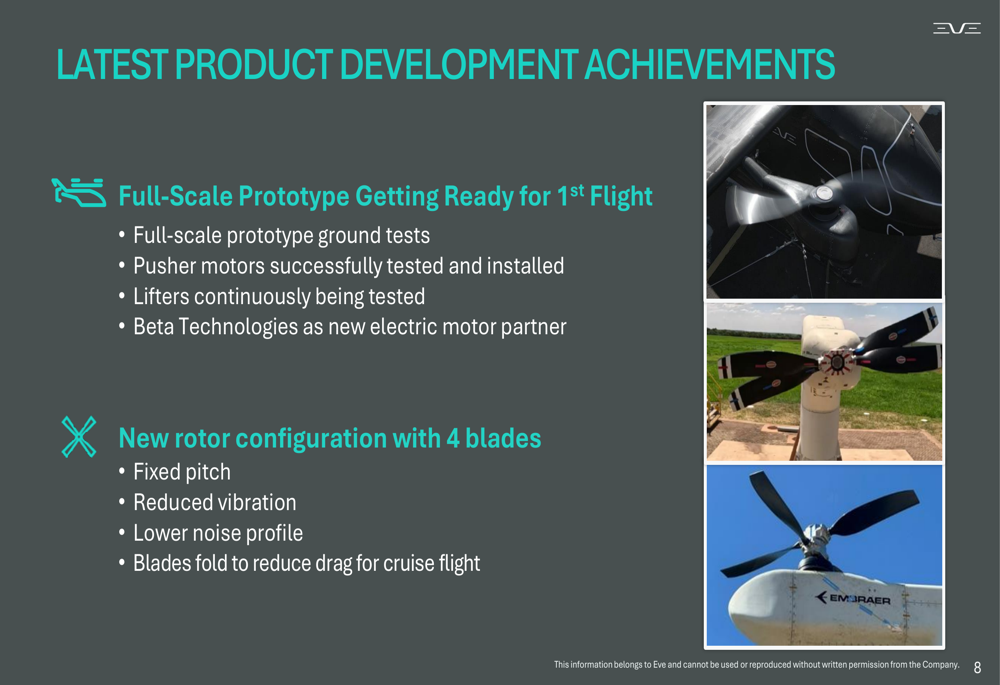
Eve also presented its extensive partner ecosystem for primary systems and components, demonstrating the collaborative approach to aircraft development. Major partners include Nidec, BAE Systems (LON:BAES), Recaro, Garmin (NYSE:GRMN), Thales (EPA:TCFP), Honeywell (NASDAQ:HON), and numerous other aerospace suppliers providing critical systems from motors and batteries to avionics and interior components.
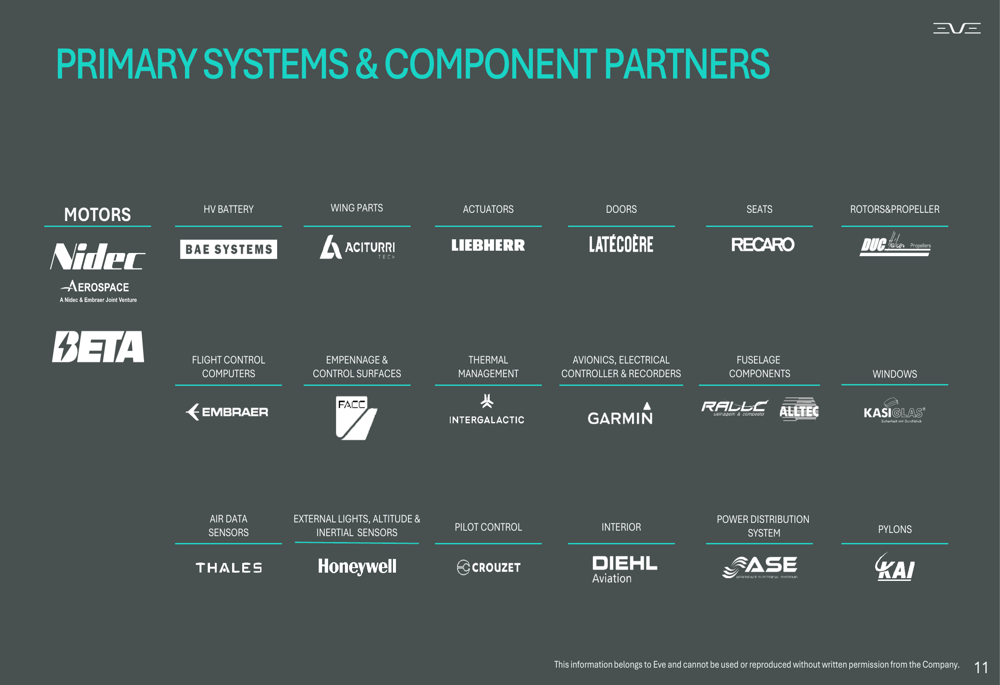
Forward-Looking Statements
Eve outlined several key milestones it aims to achieve in 2025, with all initiatives currently reported as on track. The company expects the full-scale prototype to complete its first flight between late 2025 and early 2026, marking a critical step in the development program.
Other milestones include alignment of the detailed certification plan with aviation authorities ANAC (Brazil) and FAA (US), initial production of the certification prototype, and preparation of eVTOL manufacturing and testing facilities. The company reiterated its 2025 total cash consumption projection of US$200-250 million.
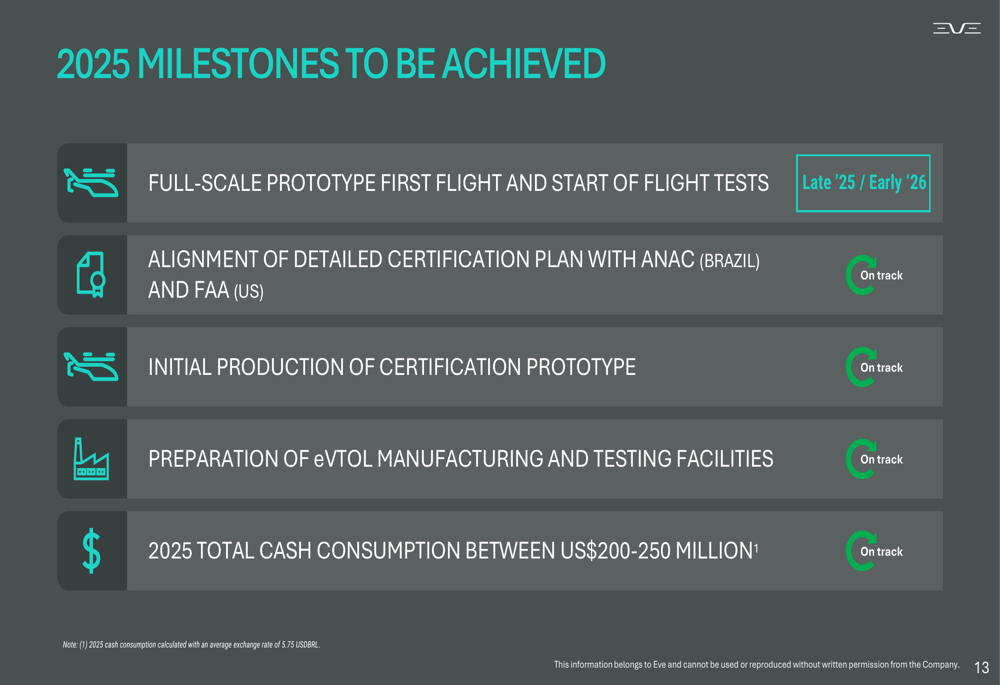
Eve continues to target 2027 for entry into service, positioning the company to be among the early entrants in the commercial urban air mobility market. The successful showcase of the EVE-100 mock-up at the Paris Air Show 2025 represents another step in building market awareness and stakeholder engagement ahead of commercial launch.
As Eve progresses toward certification and production, the company faces both opportunities and challenges. While the binding order from Revo and expanding LOI portfolio demonstrate market interest, the company must navigate technical development hurdles, certification requirements, and significant cash consumption before achieving revenue generation from aircraft deliveries. Nevertheless, Eve’s connection to aerospace manufacturer Embraer, comprehensive solution approach, and strong partner ecosystem provide competitive advantages in the evolving urban air mobility landscape.
Full presentation:
This article was generated with the support of AI and reviewed by an editor. For more information see our T&C.
